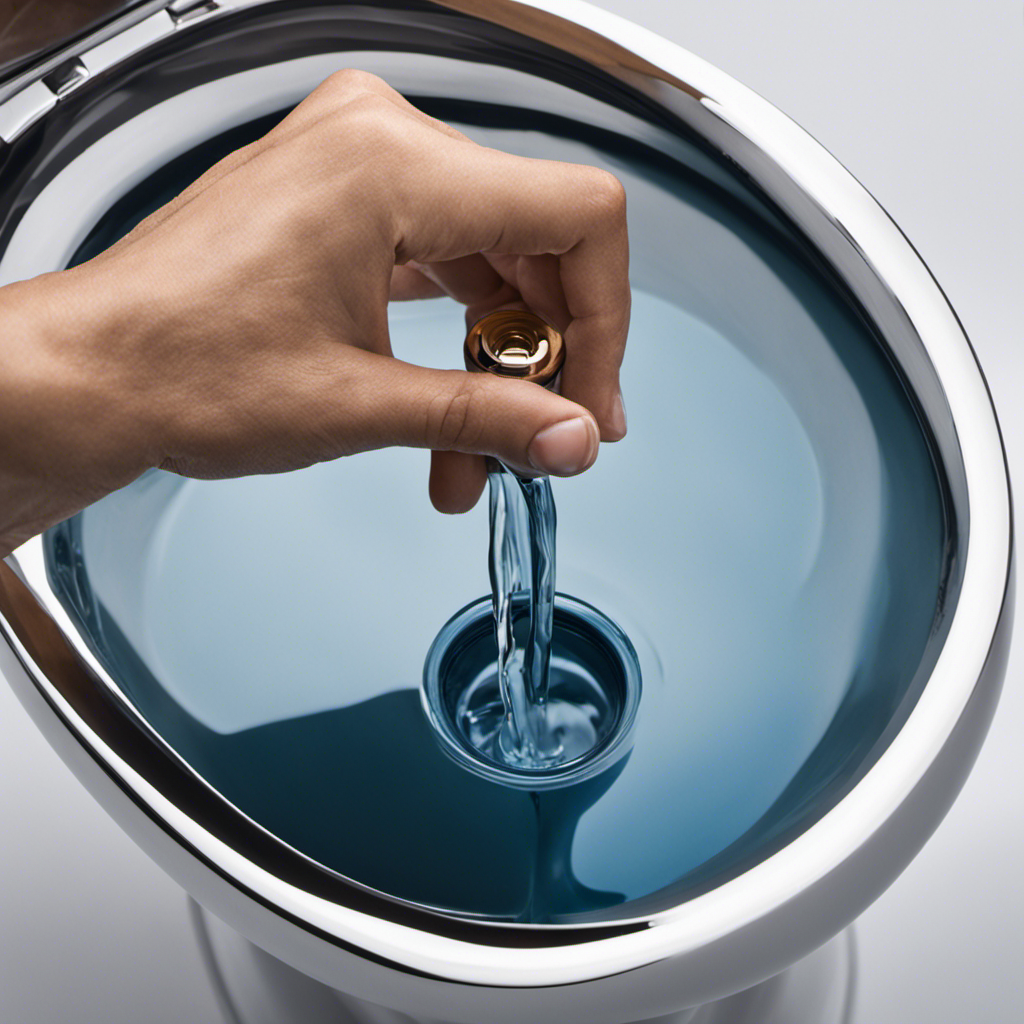Did you know that a running toilet can waste up to 200 gallons of water per day? If you’re tired of the constant sound and the rising water bill, I’ve got you covered.
In this article, I will guide you through the simple steps to stop your toilet from running. By identifying the cause, checking and adjusting the flapper, adjusting the water level, and inspecting and replacing the fill valve, you’ll have a silent and efficient toilet in no time.
Key Takeaways
- Checking the flapper and fill valve can help identify common problems.
- Proper alignment of the flapper is crucial for a well-functioning toilet.
- Adjusting the water level in the toilet tank can prevent wasteful water usage and flushing problems.
- Inspecting and replacing the fill valve can restore normal functioning to the toilet.
Identifying the Cause of a Running Toilet
To identify the cause of a running toilet, you’ll need to check the flapper and the fill valve. These are two common toilet problems that can lead to continuous water flow.
The flapper is a rubber seal located at the bottom of the tank. If it is worn out or misaligned, it may not create a proper seal, causing water to leak into the bowl.
The fill valve, on the other hand, controls the water level in the tank. If it is not functioning correctly, it can result in water constantly running.
Luckily, there are DIY solutions for running toilets. For the flapper, you can try adjusting the chain or replacing it if necessary.
Regarding the fill valve, adjusting the float or replacing the entire valve can help resolve the issue.
Checking and Adjusting the Toilet Flapper
Check if the toilet flapper is properly aligned and adjust it if necessary.
The toilet flapper is a crucial component that controls the water flow from the tank to the bowl. Over time, the flapper can become misaligned or dirty, leading to a running toilet.
To check the alignment, lift the lid of the toilet tank and flush the toilet. Observe the flapper as it opens and closes. It should seal tightly against the flush valve when closed. If it doesn’t, adjust the chain or rod connected to the flapper to ensure a proper seal.
Additionally, cleaning the flapper regularly can prevent build-up that may affect its performance. If the flapper is damaged beyond repair, replacing it with a new one is recommended.
Adjusting the Water Level in the Toilet Tank
If the water level in the toilet tank is too high or too low, adjusting it can help optimize the toilet’s performance. Proper water level in the tank is important for efficient flushing and water saving techniques.
To adjust the water level, locate the water level adjustment screw or float arm on top of the fill valve. Turn the screw clockwise to lower the water level or counterclockwise to raise it.
Make small adjustments and test the flush to ensure it’s working properly. Adjusting the water level is a simple DIY toilet repair that can prevent wasteful water usage and potential issues with flushing.
Inspecting and Replacing the Fill Valve
When inspecting and replacing the fill valve, make sure you turn off the water supply to the toilet. This is essential to prevent any accidents or water damage.
The fill valve is a crucial component of the toilet that controls the flow of water into the tank. If you’re experiencing problems with your toilet constantly running or not filling properly, it’s likely due to a faulty fill valve.
Common fill valve problems include leaks, clogs, and worn-out parts. Replacing faulty components of the fill valve can often solve these issues and restore normal functioning to your toilet.
Remember to follow the manufacturer’s instructions and use the appropriate tools when replacing the fill valve.
Troubleshooting Persistent Running Issues
To troubleshoot persistent running issues, you should first ensure the water supply to the toilet is turned off. This is a common toilet problem that can be easily fixed with some DIY toilet repairs. Here are four steps you can take to troubleshoot and resolve the issue:
-
Check the flapper valve: Lift the toilet tank lid and inspect the flapper valve. Make sure it is properly sealing the flush valve opening. If it is worn or damaged, it may need to be replaced.
-
Adjust the water level: The water level in the toilet tank should be set at the recommended level. If it is too high, it can cause the toilet to continuously run. Adjust the float or the fill valve to lower the water level.
-
Clean the fill valve: Sediment and debris can accumulate in the fill valve, affecting its performance. Turn off the water supply, remove the fill valve cap, and clean any debris. Replace the cap and turn on the water supply to see if the issue is resolved.
-
Inspect the flush handle: Sometimes, a faulty flush handle can cause the toilet to run continuously. Check if the handle is loose or if the chain connecting it to the flapper valve is too tight or too loose. Adjust or replace as necessary.
Frequently Asked Questions
How Often Should I Clean My Toilet to Prevent It From Running?
I clean my toilet tank regularly to prevent bacteria growth and keep it running smoothly. Bleach can be used to clean the tank, but it’s important to follow the instructions and use it sparingly.
Can I Use Any Type of Flapper to Replace a Damaged One?
Sure, you can use different types of flappers as alternatives to replace a damaged one. However, it’s important to troubleshoot the issues with your toilet flapper to ensure the best fit and functionality.
How Can I Determine if the Water Level in My Toilet Tank Is Too High or Too Low?
To determine if the water level in your toilet tank is too high or too low, check the water line on the inside of the tank. Adjust the water level using the fill valve if needed. Troubleshooting tips for a constantly running toilet include checking the flapper and adjusting the chain.
Is It Possible to Replace the Fill Valve Without Calling a Plumber?
Yes, it’s possible to replace the fill valve without calling a plumber. I’ve done it before. It’s a simple toilet maintenance task that can save you time and money.
What Are Some Common Signs That My Toilet Is Running Even if It’s Not Visibly Leaking?
Some common signs that a toilet is running include hearing a constant water flow, noticing a higher water bill, or seeing water continuously filling the bowl. Troubleshooting toilet running involves identifying the causes and taking appropriate steps to fix the issue.
Conclusion
In conclusion, fixing a running toilet is a simple task that you can easily tackle on your own. By identifying the cause, checking and adjusting the toilet flapper, adjusting the water level, and inspecting and replacing the fill valve if needed, you can put an end to that annoying and wasteful running water.
So why let your toilet continue to waste water and money? With these simple steps, you can have a properly functioning toilet in no time.










